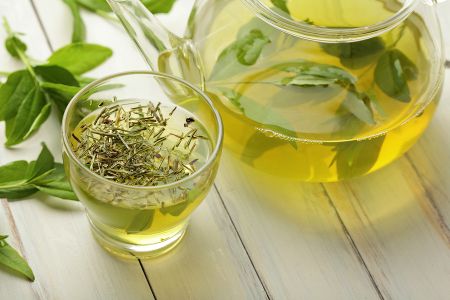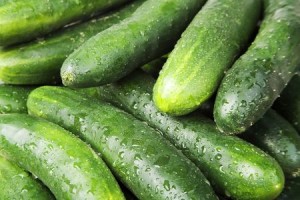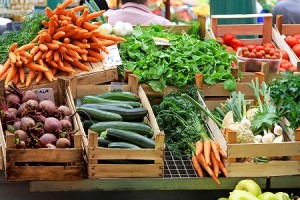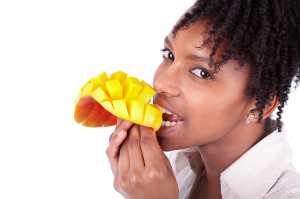

It’s easy to get confused about tea, with the seemingly endless array of types in the marketplace – from cranberry apple, to lemon zinger, to orange pekoe, and more. The truth of the matter is that tea, true tea, comes only from one plant: Camellia sinensis, and everything else is technically an ‘infusion’. Herbal ‘teas’ are infusions brewed from the leaves, stems, flowers, or any other part of any edible plant.
Tea has been suggested in studies to lower the risk for many diseases

All teas have antioxidants – in particular a class of polyphenols called ‘flavonoids’. Freshly picked tea leaves have an abundance of flavonoids; however, the amount of polyphenols decrease during fermentation. This is why green and white teas have higher contents of polyphenols than does black tea. Green is probably best known for being an excellent source of antioxidants, with white tea gaining popularity – both are generally grouped with superfoods because of their powerful contributions to health.
A large body of research suggests an inverse association between green tea consumption and rates of prostate, colon, and breast cancers, as well as liver and heart disease: the more green tea consumed, the lower the rates of those diseases. Green tea also appears to help protect the skin from sun damage, including skin cancer, and lowers the risk for heart disease. But it doesn’t stop there. Recent research has demonstrated how the different polyphenols in green tea are able to penetrate various parts of the eye, including the retina, lens, and aqueous humor (a thick watery compartment that fills the space between the lens and the cornea), which may offer protection against cataracts.
Green tea may lower blood pressure and reduce inflammation
A new study has demonstrated that the polyphenols in green tea offer another tool in the fight against high blood pressure and related disease risks in those who are overweight or obese.
The blood pressure reduction was not trivial: significant reductions in both systolic (the top number, i.e. 130) and diastolic (the bottom number, i.e. 85) blood pressure were seen – about 4.9 and 4.7 mmHg, respectively – which is impressive.Other benefits included improved insulin sensitivity (meaning the body is better at handling blood sugar), and reduced inflammation (considered an independent risk factor for cardiovascular disease), and oxidative damage (from ‘free radicals’).
How much?
Researchers found benefits with as little as 208 mg of EGCG, one of the four main polyphenols in green tea. That translates to just under 1½ cups of high quality Japanese sencha green tea (each cup has about 150 mg EGCG) or about seven cups of poorer quality green tea (the kind used to make most bagged tea, each cup of which yields about 30 mg EGCG). You can get by on less green tea consumption with a higher quality tea, or simply drink more cups of the less potent kind.
Caveat Not
To get the most benefit, mimic the behavior of the long-lived in Asian cultures: aim to have several cups per day of good-quality green tea. Fortunately, green (as well as white) tea has a lot less caffeine than black tea or coffee, so you can drink it with peace of mind – in more ways than one!
Learn more about the Trim Down Club and healthy eating habits.
Comments 39
Leave a Reply
You must be logged in to post a comment.




I love green tea I am from Australia I find it to be a great durectiice liked the in fo
all tea is healthy and have antioxidants, including black tea…enjoy with confidence!
am i ok to have a normal cup of tea with this diet? I don’t take sugar but do have a bit of 1% fat milk in it, if this is ok to have whats the maximum a day you would recommend please…. thanks.
I’ve just joined Slim Down Club, hope I can do it. I’ve been drinking green tea for many years, Tetley pomegrante green tea without adding anything to it. I have tried others and didn’t like them.
I’ve been drinking green tea for many years. I’ve tried many others but now only drink Tetley pomagranate which I get at the supermarket. I don’t add anything to it. Hope it’s as effective as others I’ve been reading about below.
I buy loose (not bagged) green tea with jasmin from an international store in Ohio. The store’s name is Jungle Jim’s and Twinings is the brand of tea. Surely anyone who buys tea has heard of Twinings as it is a popular brand. It comes in a tin and you will need a tea ball, which is what you put your tea in when you steep it, to brew your tea. I hope this helps some people, and I’m sure you can order it online. It doesn’t seem to be that expensive either… I wish I could post an image of here..
Hi, wickerdl. The best green teas tend to be those imported from the orient, and not packaged by large Western companies. Since it is very light, you can always order it over the internet, with minimal shipping costs.
Hi, VincentPrice. Herbal peppermint tea (from the peppermint plant) is not tea, but rather an “infusion,” similar to tea. However, if you find peppermint-flavored tea, check the label as to whether or not the basis is from green or black tea (different species than peppermint).
Hi, MaryLinda. Sorry to read of your difficulties. In general, more than 3 cups per day is not really recommended.
I am allergic to green tea in larger amounts. One day I had about six cups as I was told of the benefits and that one could drink as much as they wanted, but it closed my bladder down. It was so painful because I actually could not pee, and I ended up in the hospital with a catheter. I know this sounds crazy, but I stay away from it now, and my brother tried it and the same thing happened to him, so it may be a hereditary problem. But anyone who drinks it and suddenly has a problem trying to urinate should be aware of this and seek medical help immediately. However, my brother and I don’t have a problem at all with black tea.
Very interesting but no help in telling me how to buy the right kind of green tea! what do you look for in the store? Our shopping opportunities are limited due to the rural area in which we live. Thank you.
I drink a lot of pepermint tea, is this a green tea?
good. very helpful about green tea.
I make a pot of green tea, let it steep, then cool and put it in a juice container in the fridge. I add the juice and a few slices of lemon to the container. It is my ‘iced tea’ for the day. At first I needed to add sweetener, but now, I just find it refreshing the way it is!
thank you for this well done article, i drink the green which i get in the market,but i would like to know how long i keep boiling .
Does it harm polyphenols if i boil the green tea more than it should.
Abdulahi
thank you for this info on tea..i never drink it i only drink water..and sometimes low sodium v8..but i have high bp and arthritis..hopefully i’ll get some relief..for the pain..
I have heard that adding any type of milk to tea reduces the polyphenols or the benefits of drinking tea, is this true and if it is for some, but not others which are acceptable to mix with your tea? (for example: almond milk, soy milk, skim milk, etc.) In addition would bloating occur from drinking green tea?
Can you take the green tea supplements?
I’m not a fan of green tea. Drinking it makes me feel queasy. However I’m giving it another try. I find it better if I drink it cold. I can’t drink it without a sweetener but I like the idea of honey and lemon, so I’m going to try that. I am going to persevere for a week. I don’t think ‘ll ever be able to drink a lot of it, but you never know, I might get used to it eventually! 🙂 I’ve only just heard of white tea, so perhaps I’ll try that too. 🙂
What can you do to help it not tast so bitter
Does green tea help me to lower my triglycerides?
I love drinking coffee in the mornings but I drink 2 cups of green tea in the afternoons and It,s relaxing!
How do you know you are getting quality Japanese sencha green tea? I am searching it on the internet and there are many brands and many prices.
Where can I find high quality Japanese sencha green tea ?
Asian markets or health food stores and ask the employee
Is it okay to drink green tea with honey and lemon? Is that still healthy
I get my green tea from china. My son lives there so he gets me the best. It is very refreshing cant do with out it hot or cold. Make a lardge jug let it cool put in fridge had ice cub to your glass very refreshing in hot weather.
@carolineoc. Caffeine helps to reduce headaches which is why some pharmaceutical companies add it to over the counter pain killers. Drinking 10 cups of coffee per day will give you a lot of caffeine, over 1000 mg, general healthy guidelines (at least here in Canada) are to limit caffeine to about 400 mg per as a general rule. I don’t know if green tea will help with headaches, the amount of caffeine in green tea is a lot less than coffee so it may not help from that perspective and yes, you might get headaches from abrupt caffeine withdrawal….cut back gradually if you want to reduce your caffeine consumption
@humandancer – i think small amounts of soy beverage made from whole organic soy beans is fine, and as you said, you can use almond or even rice beverage too
@Genevieve90 I buy my green tea in specialty tea shops and tea houses to get the better quality ones
@kayrivers30, all green tea will have the beneficial polyphenols, some more than other which means you can drink less to get the same amount. Some of the best are Japanese Sencha, or matcha. I buy my green tea in specialty tea shops and tea houses to get the better quality ones
@Muffyq, green tea, as part of an overall healthy diet, can help to increase your intake of phyto-nutrients, plant compounds that have many health benefits. Green tea is much lower in caffeine and I especially like blends like green tea and pear, green tea and jasmine as a way to introducing it as a beverage and for variety
@transport60 – that’s great to hear…green tea has far reaching health benefits, those polyphenols go a long way!
Having suffered headaches on a regular basis now for many years and finding that when drinking black coffee it seems to alleviate the agony, drink several maybe ten cups some days, I’m wondering have I become dependent on the caffeine with the fact the pain clears after the coffee, (take pain killers at times also). Might you suggest that the green tea could be beneficial to me with it not having caffeine —- might there be a period of withdrawal from the caffeine based drink to the non- caffeine based drink? I thank you for any advice I may receive.
I therefore aim to cut the soya milk and drink green and white tea.
Which milk is safer as I don’t want to use cow’s milk? What about almond milk in the occasional black tea?
Where do I buy this tea?
I am anxious to start green tea. My blood pressure gyrates up and down with systolic rising near 200. My cortisol is high and I am overweight approximately. 30 p0unds. I am in my eighties but my mental acuity is sound. I have tried everything but nothing helps. I am hoping this site will help. so far I am learning information that is new to me. We will see! I am sure that I am unusual to this type of site. Others may learn from my journey. Being from the greatest generation, is not as unusual as everyone may think. I haven’t died yet!. Thank you all for your inputs. Green tea here I come!
thanks for the comment about the caffeine in green tea being less than black. I have wanted to get going on it, but was concerned about the caffeine, so have been having a small cup in the morning and not brewing it very long. I’m excited about all it’s benefits!
So is there a recommendation of type of green tea that would be more suitable for that would help to reduce blood pressure, weght loss and reduct inflammation.
I was very interested to read about the various benefits of drinking green tea. My daughter who is a Consultant in Ophthalmology was delighted when I told her I had started to drink green tea after joining the Trimdown Club because of the great benefits to eye health .